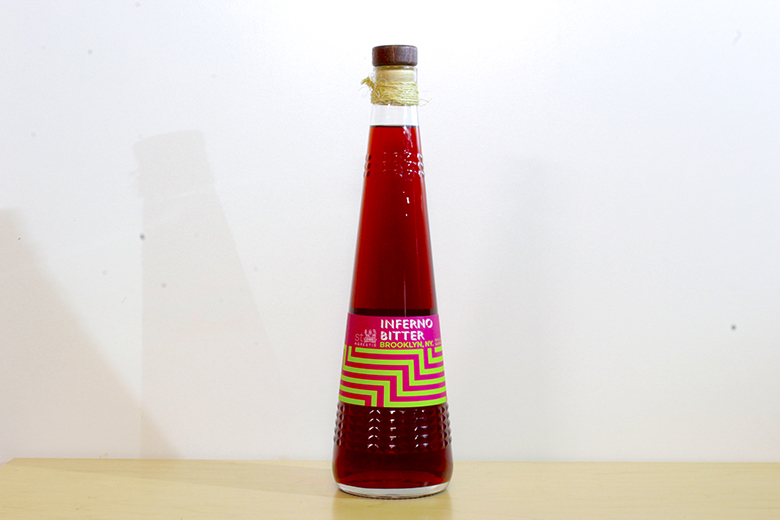
What came first: the bitter red aperitivo or the Negroni? In the case of Greenpoint–based amaro-maker St. Agrestis, the answer is murky. Technically, their bottled Negroni four-packs, featuring a psychedelic, ’60s-style label, hit shelves in the spring of 2018. Suddenly, the three-part cocktail of gin, sweet vermouth and red aperitivo could be a picnic staple—as easy to pop open as a soda or beer.
The ingredients listed Greenhook Gin, vermouth and something called St. Agrestis Inferno Bitter. Unbeknownst to those casually picking up the bottled beverage at their local liquor store, that Inferno Bitter, not yet on the market, was the impetus behind producer Louis Catizone’s foray into the distilling world. This spring, it finally becomes available in a 750-milliliter bottle all its own. Egg and chicken, to belabor the point, together side by side.
St. Agrestis Amaro, their first release, was born in 2014, the product of two sommeliers, Nicholas Finger and Fairlie McCollough, who met on a trip to Italy and fell in love, both with each other and with regional versions of the bitter Italian digestif. Catizone, who had worked on the distribution side of the drinks business, stepped in to buy the brand with a partner in 2017. (His only adjustment was dialing back the sugar by 25 percent.) At that time, he’d already been working on the Inferno Bitter, tweaking a recipe that he hoped could provide Campari with some artisanal competition.
https://www.instagram.com/p/Bw77B3gHmoU/
That, of course, wasn’t so simple. “There’s a reason Campari doesn’t reveal anything,” Catizone tells me. “When I was creating this, my goal was to create something similarly bitter but made with small-producer principles.” He explains that to him, this means organic ingredients, no extracts and no artificial dyes. “I think there’s something to be said about just being able to taste realness, not cutting corners, making everything under one roof,” he says. “Transparency, but not total transparency. I reveal how many botanicals, the category that they fall under, but I can’t reveal my whole formula.”
There are a lot of red bitter aperitivos that have reached the U.S. market in the last five years but, he says, they “miss on bitterness,” making them an improper replacement in the Negroni. “Some of them are really delicious as modifiers in other cocktails,” he admits, but “this is a one-to-one replacement for Campari.” It’s true that many, following small-batch standards, have sought out new flavor profiles more reflective of local terroir or simply their makers’ own tastes.
Inferno gets its bold red color from hibiscus flowers and “a tiny bit of vegetable extract that has no impact on flavor and aroma, but it just brightens it up.” There are no bugs to be found for red color in the foruma, either, as Catizone doesn’t eat meat. “The idea of making a non-vegan product is bizarre to me,” he says.
Over the last two years, he’s perfected his recipe, yet packaging held up its release. “I didn’t want to launch the Inferno Bitter in the amaro package,” he says. The Negroni was ready for market, though, and he decided to see the Inferno’s inclusion on the packaging as a way to get demand simmering. “Specifically in the last month, I’ve been getting an order every other day for the Inferno Bitter, even though it’s not out,” he says.
Now, though, the project Catizone has had in mind all along will be available for anyone getting their bar cart ready for summer. It’s a project he was born for: “My father is Italian, and I grew up drinking things like this. I had my first amaro when I was eight.” He’s also done his research, even showing up to the library at the University of Turin in search of the original recipe for a red aperitivo that Campari is rumored to use. Alas, they were closed.
“I wasn’t disappointed when I couldn’t see the formula,” he says. “I thought, ‘This is going to be better. It’s going to be completely original.’”
The Inferno Bitter does, indeed, mimic all the beauty of Campari without the smack of overwhelming sugar. First, a floral burst fills the mouth, then a healthy dose of bitterness lingers on the palate, hanging in just the right balance between sweet and herbal. If you close your eyes and the air hits you right, memories of a trip to Italy might flash before your eyes. One can see why this took years to develop, why it wasn’t ready for market without precisely the right bottle and label to convey its character. That it’s named for hell while giving off a flirty sense of leisure and luxury, though, requires explanation.
When I ask Catizone whether the name Inferno is a Dante reference, he replies, “Sort of.” It’s just a way to stick to the religious overtones of the overall name. “There will eventually be a Paradiso Aperitivo as well,” he says. A Purgatorio Bitter remains unplanned. That’s just the place we all reside between Negronis.



